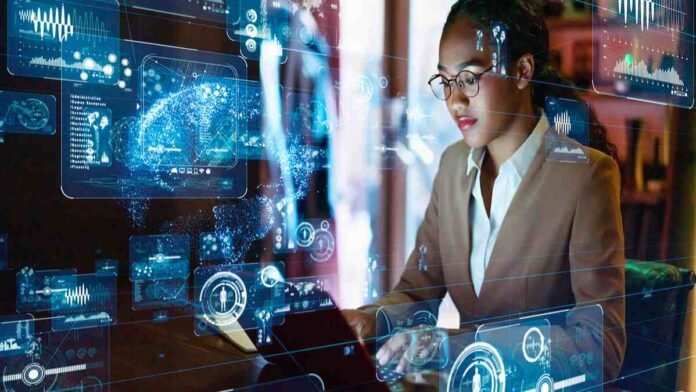AI integration in the classroom has significantly changed traditional teaching approaches. AI-powered assessment tools help identify growth areas and adapt approaches accordingly.
The use of artificial intelligence (AI) in the classroom has significantly changed how teaching approaches are used. In order to improve student learning, eliminate administrative processes, and offer more individualized learning experiences, educators are adopting AI technologies as technology advances. This article investigates how traditional teaching approaches are changing as a result of AI integration in the classroom.
The capacity of AI to provide a doorway for interactive learning and assist students in escaping the rote style of learning is one of the major advantages of integrating AI in the classroom. It offers customisation of education depending on each student’s receptive capacity and potential by enabling teachers to monitor the learning patterns of the pupils on a deeper level.
AI is useful in giving instructors the extra assistance they need to streamline the numerous jobs appropriately. By giving instructors the resources they need to provide each student in a class individualized attention, it can aid in closing the communication gap in the education sector. In conclusion, technology involvement can help do away with the one-size-fits-all methodology that might not be suitable for all kids.
An outstanding example of integrating artificial intelligence (AI) in the classroom is Intelligent Tutoring Systems (ITS). These systems use AI algorithms to give education, counsel, and feedback to pupils. By seeing and examining how students engage with the system, ITS may modify its present material to suit the individual needs of each learner.
Similar to this, conventional evaluation methods typically fail to adequately gauge pupils’ overall development and potential. AI-powered assessment tools offer a more thorough and precise evaluation of student performance. Algorithms for machine learning examine student input, uncover trends, and provide immediate feedback. This enables educators to identify potential growth areas and adapt their approach depending on the type of kid they are working with.
Collaboration between students and between students and professors is facilitated by the inclusion of AI in the classroom. Intelligent virtual assistants and chatbots may speed up communication and offer immediate assistance by addressing queries and elaborating on ideas. By giving students a place to collaborate and communicate effectively, the collaborative environment cultivates crucial abilities like critical thinking and problem-solving that are necessary for success in the digital era.
Teachers may spend more time educating and engaging students by automating administrative tasks. Grading tools that use artificial intelligence (AI) can assess student work in a timely manner by performing an accurate analysis. By employing this automated grading process, teachers may spend more time interacting with students since they save time. Additionally, AI-powered administrative solutions may aid with responsibilities like scheduling, attendance control, and further simplifying classroom administration.
Learning experiences in virtual classrooms have been facilitated by AI integration in the classroom. Through the use of virtual worlds, AI-powered platforms may bring together students from various regions and promote cooperation and communication. By encouraging active learning, these platforms enable group debates and project partnerships. The inclusion of students with various linguistic backgrounds in the learning process is also made possible by the use of AI algorithms to provide language translation and transcription services.
AI in the classroom has the potential to change instructional strategies and improve the effectiveness, personalization, and inclusivity of learning. To achieve a balance between human direction and AI help, it is crucial to address ethical issues while embracing AI technology. As AI develops, its use in the classroom has enormous potential to improve education and better prepare students for the future.
Conclusion
Artificial intelligence (AI) has significantly transformed teaching approaches by providing personalized, tailored instruction, and streamlining administrative processes. This integration has led to improved collaboration between students and teachers, fostering critical thinking and problem-solving skills. Intelligent Tutoring Systems (ITS) use AI algorithms to provide education, guidance, and feedback to students, allowing teachers to monitor their learning patterns and provide tailored support. AI-powered assessment tools help teachers identify growth areas and adapt their approach accordingly. Collaboration between students and professors is facilitated by AI, with virtual assistants and chatbots promoting effective communication and collaboration.
AI-powered administrative solutions streamline classroom administration, scheduling, and attendance control. Virtual classrooms have also been facilitated by AI integration, promoting cooperation and communication among students from different regions. However, ethical issues must be addressed to ensure a balance between human direction and AI support. As AI continues to develop, its use in the classroom has immense potential to improve education and prepare students for the future.



